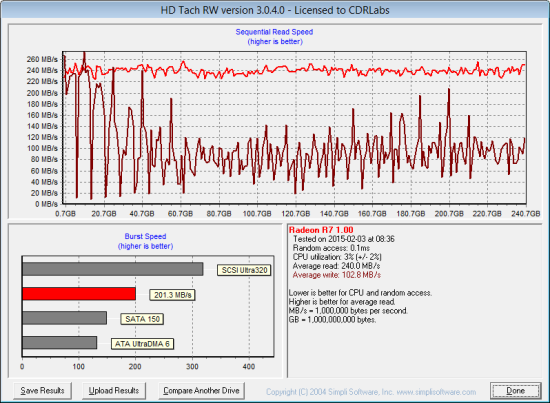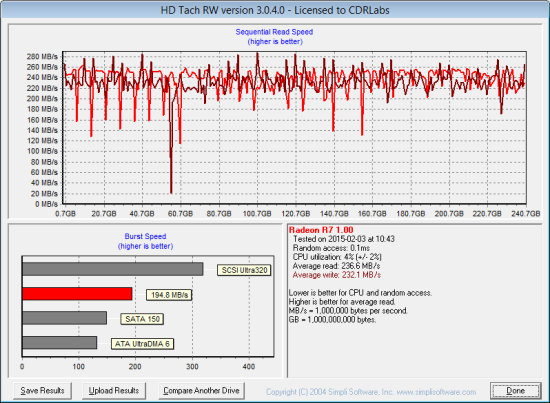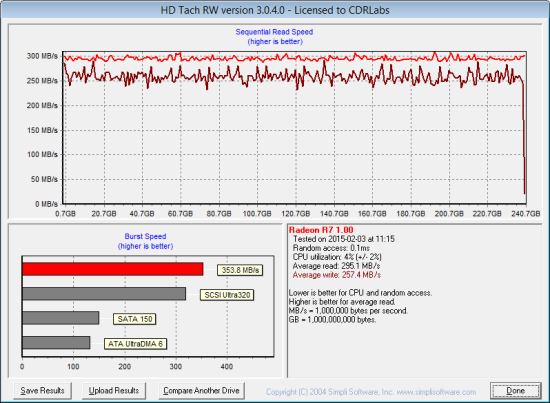TRIM Performance:
While SSD's offer many benefits, there are some downsides to using flash memory. One of the biggest issues people run into is performance degradation. Over time, an SSD will run out of fresh blocks and will have to write over data the file system has marked as deleted. This procedure is very complicated and can slow an SSD's write speeds considerably.
To fix this problem, most manufacturers have added TRIM support to their SSDs. The TRIM command allows an operating system, such as Windows 7, to tell an SSD which data blocks are no longer in use. Using this information, the drive pro-actively erases these blocks and adds them to the free block pool.

To test the Radeon R7's TRIM and garbage collection functions, I first put the drive in a "dirty" state. I used Iometer to fill the entire drive and then ran a random write test for 30 minutes. Looking at the screenshot below, you can see that the Radeon R7's average read and write speeds dropped to 240.0 MB/s and 102.8 MB/s, respectively.

OCZ Radeon R7 - Dirty
I let the computer sit for a couple of hours and then reran the test. The drive's average write speed jumped back up to 232.1 MB/s. However, its average read speed dropped down to 236.6 MB/s while it was recovering.

OCZ Radeon R7 - After TRIM
Lastly, I used the Radeon Toolbox utility to perform a secure erase on the Radeon R7. With the drive wiped clean, it had average read and write speeds of 295.1 MB/s and 257.4 MB/s, respectively.

OCZ Radeon R7 - Secure Erased
Final Thoughts:
With the Radeon R7, AMD has made its long awaited entrance into the consumer solid state drive market. The result of a partnership between AMD and OCZ, this good looking, ultra-slim drive combines the Indilinx-infused Barefoot 3 M00 controller with Toshiba's latest A19nm MLC NAND flash to deliver a good mix of performance, endurance and value. In our sequential read and write tests, the 240GB version of the Radeon R7 was able to read at speeds as high as 552 MB/s and write at speeds in excess of 485 MB/s. It also did reasonably well in our random write tests, producing almost 55,000 IOPS at low queue depths. As you'd expect, the Radeon R7 performed better at higher queue depths. However, it still had a hard time keeping up with some of the higher priced, enthusiast-oriented SSDs like OCZ's own Vector 150 and Samsung's 850 PRO.
Despite its many strengths, OCZ's Barefoot 3 controller has been around for a few years now and is starting to get a bit long in the tooth. Where the latest controllers from Marvell and Samsung offer support for Device Sleep (DEVSLP) mode and self-encrypting drive (SED) technologies that are TCG Opal 2.0 and eDrive compliant, the Barefoot 3 does not. Given, this probably isn't an issue if you're looking for an SSD for your gaming rig. However, these are things you may want to consider if the Radeon R7 is going in a laptop or you're in a situation where data security is a concern.
The Radeon R7 is available now in 120GB, 240GB and 480GB capacities. Prices on Amazon currently range from $85 up to $244, with the 240GB version reviewed here going for about $130.

Highs:
- Available in 120GB, 240GB and 480GB capacities
- Endurance rated at 30GB/day for 4 years
- Good sequential and random read and write performance
- Performs equally well with compressible and incompressible data
- SATA 6Gb/s interface
- Toggle Mode MLC NAND flash
- Large DRAM cache
- Supports TRIM and idle background garbage collection
- Well constructed design
- AES 256-bit encryption
- Includes a 2.5" to 3.5" adapter bracket
- Includes Acronis True Image cloning software
- 4 year ShieldPlus warranty
Lows:
- Random write performance at low queue depths could be better
- Does not support DEVSLP
- Does not support TCG Opal or eDrive encryption

